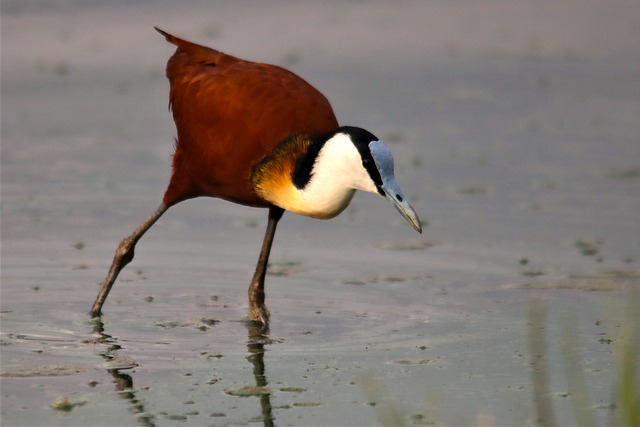
Discover the Wild Side: Top 5 National Parks in Africa

- Serengeti National Park, Tanzania: One of the most famous and well-known game reserves in Africa, the Serengeti is home to the Great Migration of wildebeest and zebras, and offers incredible opportunities for wildlife viewing. Visit – Serengeti National Park
- Masai Mara National Reserve, Kenya: A must-see destination for safari enthusiasts, the Masai Mara is famous for its incredible wildlife and the annual wildebeest migration.
- Kruger National Park, South Africa: One of the largest game reserves in Africa, Kruger is home to an impressive diversity of wildlife, including the “Big Five” (lion, leopard, elephant, rhino, and buffalo). Visit Kruger National Park
- Etosha National Park, Namibia: Known for its stark landscapes and unique wildlife, Etosha is one of the best places in Africa to see endangered black rhinos, as well as lions, elephants, and many other species. Visit Etosha National Park
- Okavango Delta, Botswana: More than just a game park, the Okavango Delta is a vast wetland area that offers a unique opportunity to explore the African wilderness by boat, as well as on foot and by vehicle. It is home to a stunning array of wildlife, including elephants, lions, hippos, and crocodiles. Visit Okavango Delta
Serengeti National Park
Serengeti National Park, located in Tanzania, is one of the most iconic and well-known game reserves in Africa. Covering an area of approximately 30,000 square kilometers, the park is home to an incredibly diverse range of wildlife, including lions, leopards, cheetahs, elephants, giraffes, zebras, and more. The park is perhaps best known for the Great Migration, a massive annual movement of wildebeest and zebras that takes place between Serengeti and Maasai Mara National Reserve in Kenya.
The landscape of Serengeti National Park is a mixture of grassy plains, savannah, and woodland, with a few rocky outcrops and hills scattered throughout. The park is home to several rivers, including the Mara, Grumeti, and Seronera, which provide water and sustenance for the park’s wildlife.
One of the best ways to experience the Serengeti is on a safari tour. Visitors can choose from a range of options, from guided game drives to walking safaris and hot air balloon rides. The park is also home to several lodges and campsites, where visitors can stay overnight and enjoy the peaceful sounds of the African wilderness.
In addition to its incredible wildlife, Serengeti National Park has a rich cultural history. The Maasai people, who have lived in the region for centuries, have a deep connection to the land and its wildlife. Visitors can learn about Maasai culture and traditions by visiting one of the many Maasai villages located near the park.
Serengeti National Park is a must-visit destination for anyone interested in wildlife and nature. Whether you’re watching the Great Migration, spotting the Big Five, or simply taking in the stunning scenery, the park is a truly unforgettable experience.
The Masai Mara National Reserve
The Masai Mara National Reserve, located in southwestern Kenya, is one of the most popular game reserves in Africa. Covering an area of approximately 1,500 square kilometers, the reserve is home to a wide range of wildlife, including lions, cheetahs, elephants, giraffes, zebras, and many more.
One of the biggest draws of the Masai Mara is the annual wildebeest migration, which takes place between July and October. During this time, over a million wildebeest, zebras, and other animals make their way from the Serengeti in Tanzania to the Masai Mara in search of fresh grazing land. The migration is a truly awe-inspiring sight, with massive herds of animals moving in unison across the grassy plains.
In addition to the Great Migration, visitors to the Masai Mara can enjoy a wide range of safari activities. Guided game drives are a popular option, allowing visitors to explore the park’s diverse landscape and spot some of its famous wildlife. Walking safaris and hot air balloon rides are also available, offering a unique and exciting way to experience the park.
The Masai Mara is also home to several Maasai villages, where visitors can learn about the culture and traditions of the local people. The Maasai have lived in the region for centuries and have a deep connection to the land and its wildlife. Visitors can witness traditional dances, learn about Maasai customs, and even stay in a traditional Maasai boma (homestead).
Overall, the Masai Mara National Reserve is a must-visit destination for anyone interested in wildlife and nature. With its incredible wildlife, stunning scenery, and rich cultural heritage, it’s no wonder that the park is one of the most popular destinations in Africa.
Kruger National Park
Kruger National Park, located in northeastern South Africa, is one of the largest game reserves in Africa, covering an area of approximately 19,485 square kilometers. The park is home to an incredible diversity of wildlife, including the famous “Big Five” (lions, leopards, elephants, rhinos, and buffalo), as well as giraffes, zebras, hippos, crocodiles, and many other species.
One of the best ways to experience the park is on a guided game drive. Visitors can choose from a range of options, from day tours to multi-day safaris, and explore the park’s diverse landscape and wildlife. Walking safaris are also available, allowing visitors to get up close and personal with the park’s smaller creatures and learn about the local flora and fauna.
In addition to its wildlife, Kruger National Park has a rich cultural history. The park is home to several archaeological sites, including evidence of early human habitation and rock art dating back thousands of years. Visitors can learn about the park’s cultural heritage by visiting the Stevenson-Hamilton Memorial Library and Museum, which houses a collection of artifacts and documents related to the park’s history.
Kruger National Park is also home to several campsites and lodges, ranging from basic camping facilities to luxury lodges with all the amenities. Visitors can enjoy a range of activities, from guided nature walks to bird watching and stargazing.
Overall, Kruger National Park is a must-visit destination for anyone interested in wildlife and nature. With its incredible diversity of wildlife, rich cultural heritage, and stunning landscapes, it’s no wonder that the park is one of the most popular destinations in Africa.
Etosha National Park
Etosha National Park is a game reserve located in northwestern Namibia, covering an area of approximately 22,270 square kilometers. The park is known for its vast salt pan, which dominates much of the landscape and provides a unique habitat for a wide range of wildlife.
One of the biggest draws of Etosha National Park is its abundant wildlife, including lions, elephants, giraffes, zebras, and many other species. The park is also home to over 300 bird species, making it a popular destination for bird watchers.
The park is best explored on a self-drive safari, with visitors driving their own vehicles through the park’s network of gravel roads. Several rest camps are located throughout the park, offering basic accommodation and amenities. Visitors can also choose from a range of guided game drives and walking safaris, allowing them to get up close and personal with the park’s wildlife.
One of the unique features of Etosha National Park is the Etosha Pan, a massive salt pan that covers approximately 4,730 square kilometers of the park. During the dry season, the pan is a stark, white landscape, while during the wet season, it fills with water and attracts a range of birdlife and other animals.
In addition to its wildlife, Etosha National Park has a rich cultural history. The park is home to several indigenous communities, including the Himba and Herero people, who have lived in the region for centuries. Visitors can learn about the local culture and traditions by visiting one of the many villages located near the park.
Overall, Etosha National Park is a must-visit destination for anyone interested in wildlife and nature. With its unique salt pan habitat, abundant wildlife, and rich cultural heritage, it’s a truly unforgettable experience.
Okavango Delta
The Okavango Delta is a vast wetland located in Botswana, covering an area of approximately 15,000 square kilometers. The delta is formed by the Okavango River, which flows into the Kalahari Desert and creates a unique and diverse ecosystem.
One of the biggest draws of the Okavango Delta is its incredible wildlife. The delta is home to over 200 species of mammals, including lions, leopards, elephants, hippos, and crocodiles, as well as a wide range of bird species. The delta is also home to several endangered species, including the African wild dog and the cheetah.
Visitors to the Okavango Delta can explore the area on foot, by boat, or on a guided safari. Walking safaris offer a unique opportunity to experience the delta’s smaller creatures and learn about the local flora and fauna. Boat safaris are also popular, allowing visitors to explore the delta’s winding waterways and observe its many water-loving animals.
One of the unique features of the Okavango Delta is the mokoro, a traditional dugout canoe used by the local people for transportation and fishing. Visitors can take a guided mokoro trip through the delta, allowing them to get up close and personal with the area’s wildlife and experience the traditional way of life of the local people.
In addition to its wildlife, the Okavango Delta is also home to several indigenous communities, including the San people, who have lived in the region for thousands of years. Visitors can learn about the local culture and traditions by visiting one of the many villages located near the delta.
Overall, the Okavango Delta is a must-visit destination for anyone interested in wildlife and nature. With its incredible diversity of wildlife, unique ecosystem, and rich cultural heritage, it’s a truly unforgettable experience.

